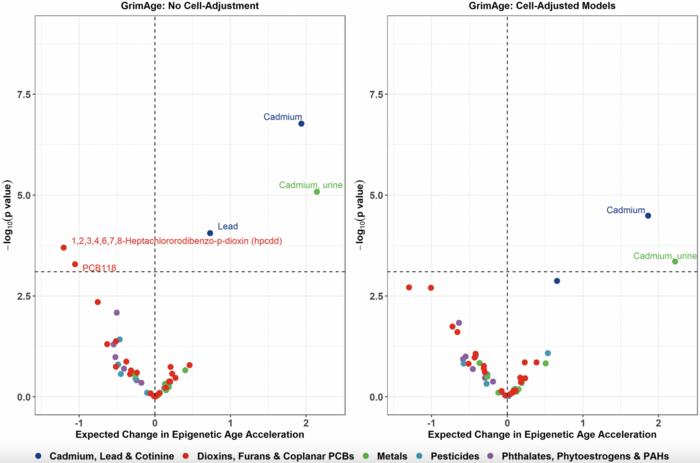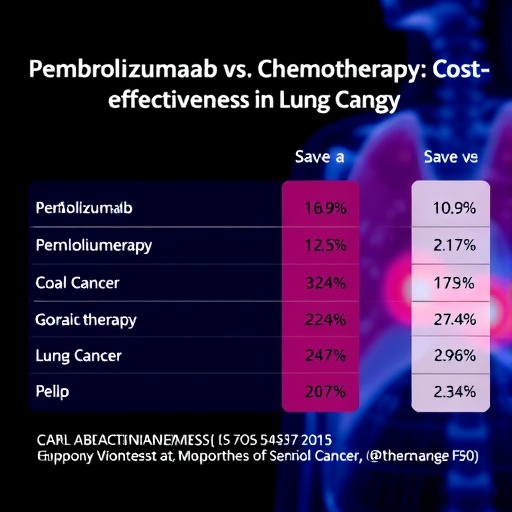
A groundbreaking study, recently published in the esteemed journal Aging-US, has unveiled that environmental chemical exposures may significantly impact epigenetic aging, a crucial factor in understanding longevity and health in humans. The research focuses on individuals from the National Health and Nutrition Examination Survey (NHANES), where the interplay between exposure to various harmful chemicals and the biological aging process was meticulously explored. The findings signal a profound connection between environmental pollutants and the acceleration of aging, underlining the dire need for public health interventions aimed at reducing such exposures.
The investigation was led by a team from Stanford University, spearheaded by first author Dennis Khodasevich in collaboration with corresponding author Andres Cardenas and a cadre of specialists from various U.S. institutions. Their work stands as one of the largest studies of its kind, examining data from 2,346 adults aged 50 to 84 years. These participants had their blood and urine analyzed for a diverse range of 64 different chemicals, which included toxic metals, industrial pollutants, and various pesticides. Such a comprehensive assay provides a solid framework for understanding how multiple exposures can collectively influence the aging process at a cellular level.
Among the myriad chemicals investigated, cadmium, lead, and cotinine emerged as the strongest correlates of accelerated biological aging. Cadmium, widely recognized as a toxic substance prevalent in cigarette smoke and certain food sources, was notably linked to marked indications of swift aging. Elevated blood levels of this heavy metal not only manifested in accelerated biological markers but also heralded an increased risk for numerous age-related diseases. This discovery shines a spotlight on cadmium as a toxic environmental agent of significant concern for public health.
Cotinine, a biomarker for tobacco exposure, reinforced the detrimental implications of smoking within the context of this study. Participants exhibiting higher levels of cotinine in their systems also demonstrated signs of premature aging. This finding further corroborates the well-established view that tobacco use has profound implications beyond the immediate health risks associated with smoking, extending its impact into the realm of epigenetic changes that affect aging.
Lead, another potent toxin that has historically been a public health hazard, particularly in relation to old paint and polluted water, surfaced as another significant contributor to expedited biological aging. The adverse effects of lead exposure are well-documented, but this study adds a crucial dimension by positioning lead exposure as a direct factor in accelerating the aging process, thereby linking it to an increased vulnerability to chronic diseases such as cardiovascular issues and neurological degeneration.
Interestingly, the research also highlighted certain pollutants exhibiting potential inverse relationships with biological aging markers. For instance, some polychlorinated biphenyls (PCBs) and dioxins seemed to correlate with slower biological aging rates. However, this observation is fraught with uncertainties; previous literature suggests that slower aging could still be associated with health risks, warranting further investigation into the dual nature of these chemical exposures.
One of the remarkable aspects of this study is its breadth; it examined exposures to a wider array of environmental chemicals than previous studies, which often concentrated on a handful of pollutants. This expansive approach underscores the complexity of human exposure to environmental chemicals and emphasizes the necessity of understanding these interactions within diverse populations, especially in a national health context.
The results of this research carry significant implications for public health policy and environmental regulations. With evidence suggesting that common exposures to toxic substances can contribute to biological aging and subsequent chronic disease susceptibility, there is a heightened urgency for policymakers to implement stronger environmental protections. Strategies aimed at mitigating exposure to harmful substances like cadmium and lead—common in smoking, industrial emissions, and contaminated food sources—could play a pivotal role in promoting health across populations.
As the discourse around environmental determinants of health evolves, the findings from this study advocate for a paradigm shift in how health risks are perceived and addressed. The traditional focus on individual lifestyle choices must be augmented with an increased awareness of environmental factors that jointly influence health outcomes. By doing so, public health initiatives can be more effectively designed to combat the impacts of pollution on aging and chronic diseases.
The implications of the research extend beyond individual health, empowering the scientific community to forge innovative pathways for studying the intersection of environment and human health. The exploration of epigenetic aging in relation to chemical exposures opens avenues for further research that may lead to novel preventative measures or therapeutic strategies against age-related ailments.
Ultimately, this study serves as a clarion call for heightened vigilance regarding environmental health issues. It emphasizes the interconnectedness of our surroundings with biological processes, urging both individuals and collective bodies to advocate for cleaner air, safer foods, and rigorous monitoring of environmental pollutants. Only through systemic change can the growing concerns regarding aging, longevity, and chronic disease be adequately addressed in a meaningful way.
The findings represent a substantial contribution to our understanding of how enviromental exposures impact biological aging. As more research unfolds in this vital area, the hope is to elucidate clear pathways for action, safeguarding human health against the persistent threats posed by environmental hazards. The research underscores the urgency for a synergistic effort involving researchers, regulatory bodies, and the public to ensure a healthier, more sustainable future.
In conclusion, this groundbreaking study is quintessential in establishing a pivotal link between environmental exposures and the complex mechanisms of epigenetic aging. It highlights a critical dimension of public health that necessitates continuous inquiry and proactive measures against exposure to hazardous substances. The findings are a vital reminder of the influence our environment has on our health trajectories, equipping us with the knowledge necessary to forge healthier communities.
Subject of Research: Environmental chemical exposures and epigenetic aging
Article Title: Exposome-wide association study of environmental chemical exposures and epigenetic aging in the national health and nutrition examination survey
News Publication Date: 11-Feb-2025
Web References: Aging-US
References: DOI: 10.18632/aging.206201
Image Credits: Copyright: © 2025 Khodasevich et al.
Keywords: aging, epigenetic aging, environmental exposures, exposome, epigenetics
Tags: biological aging and environmental exposurecomprehensive chemical exposure analysisconnection between pollutants and health outcomesenvironmental pollutants and agingepigenetic aging and health riskshealth effects of heavy metalsimpact of toxic chemicals on healthNational Health and Nutrition Examination Surveypesticides and aging processpublic health interventions for pollutionresearch on aging and longevityStanford University aging study





